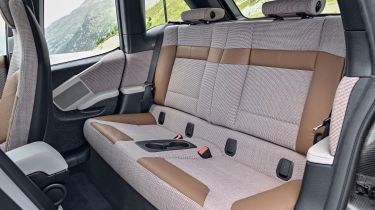BMW i3 (2013-2022) boot space & seating
Compact dimensions belie the BMW i3's roomy interior, but it only has seating for four
| Length | Width | Height | Boot volume (seats up/down) |
|---|---|---|---|
| 4,006mm | 1,791mm | 1,590mm | 260/1,100 litres |
The interior of the BMW i3 feels light and airy, thanks not just to the car's tall body, but also because the cleverly designed interior and materials create a spacious ambience.
BMW i3 interior space, storage & comfort
Up front, the i3 is blessed with the sort of space and seating adjustability you find in any other BMW. There’s plenty of room for drivers of all shapes and sizes to get comfortable and the layout of the controls and instruments is designed for easy use. It’s not too bad in the back, either – at least for a car that takes up as little space as the i3 does on the road.
However, it’s only a four-seater with no middle seatbelt on the back bench, and taller adults may feel a little cramped. On the plus side, the extensive glass areas on the rear doors means it never feels claustrophobic and a flat floor ensures plenty of foot room.
The rear-hinged back doors promise easy access, but the reality isn't great. You can only open the rears by opening the front doors first – they overlap – and the under-floor batteries mean you have to step up a little awkwardly to get into the rear seats.
It's also very easy to find yourself trapped between the open front and rear door if you're in a tight parking spot trying to access a child seat. Storage around the interior is decent, though, with cupholders front and rear, plus a cubby under the centre armrest and a glovebox with a lid.
Boot space
The boot space in the rear of the i3 is fairly compact at just 260 litres, but it’s easy to load as there's no sill, and you can fold the split rear bench to access 1,100 litres if you're not carrying rear passengers. There’s no engine in front; lifting the bonnet reveals a storage tray where you can keep the charging cable.



